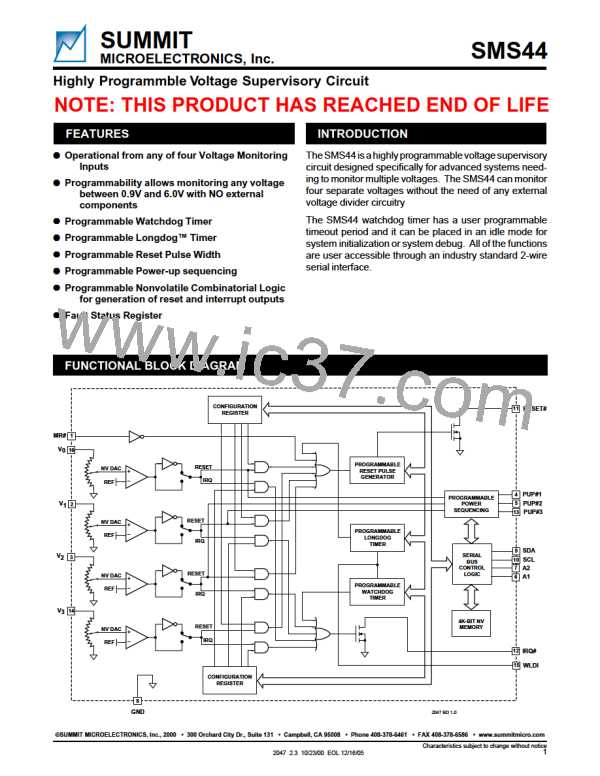SMS44
PI N DESCRI PTI ON S
V0 through V
3
MR#
Theseinputsareusedasthevoltagemonitorinputsandas
thevoltagesupplyfortheSMS44. Internallytheyarediode
ORed and the input with the highest voltage potential will
be the default supply voltage.
t
DMRRST
t
t
RESET#
PRTO
PRTO
TheRESET#outputwillbetrueifanyoneofthefourinputs
isabove1V. However,forfulldeviceoperationatleastone
of the inputs must be at 2.7V or higher.
2047 Fig01 1.0
Fi gure 1.
RESET# Ti mi ng wi th MR#
The sensing threshold for each input is independently
programmable in 20mV increments from 0.9V to 6.0V.
Also, the occurrence of an under- or over-voltage condi-
tion that is detected as a result of the threshold setting can
be used to generate subsequent action(s), such as RE-
SET#orIRQ#. Theprogrammablenatureofthethreshold
voltage eliminates the need for external voltage divider
networks.
I RQ#
The interrupt output is an active low open-drain output. It
will be driven low whenever the watchdog timer times out
or whenever an enabled under-voltage or over-voltage
condition on a V input exists (conf i gurati on regi ster 6).
PUP#1, PUP#2 , PUP#3
V
V
t
RST
PTH
These are the power-up permitted outputs when the
SMS44isprogrammedtoprovidethesequencingofLDOs
or DC to DC converters. Each delay is independently
enabled and programmable for its duration (conf i gura-
ti on regi ster )7. If all PUP# outputs are enabled the
sequence would be as follows: V0 above threshold then
delay to PUP#1 turning on; V1 above threshold then delay
to PUP#2 turning on; V2 above threshold then delay to
PUP#3 turning on to end the sequence.
V
— V
3
0
t
D
PRTO
RESET#
I RQ#
2047 Fig02 1.1
MR#
The manual reset input always generates a RESET#
output whenever it is driven low. The duration of the
RESET# output pulse will be initiated when MR# goes low
and it will stay low for the duration of MR# low plus the
Fi gure 2 .
RESET# Ti mi ng wi th I RQ#
WLDI
programmed reset timeout period (tPRTO). If MR# is Watchdogandlongdogtimerinterruptinput. Alowtohigh
broughtlowduringapower-on-sequenceofthePUP#sthe transition on the WLDI input will clear both the watchdog
sequencewillbehaltedfortheresetduration,andwillthen and longdog timers, effectively starting a new timeout
resume from the point at which it was interrupted. If MR# period.
is low the configuration registers can be read or written to
If WLDI is stuck low and no low-to-high transition is
so long as at least one of the VX inputs is ≥2.7V.
received within the programmed tPWDTO period (pro-
grammed watch dog timeout) IRQ# will be driven low. If a
RESET#
transition is still not received within the programmed
The reset output is an active low open drain output. It will
tPLDTOperiod(programmedlongdogtimeout)RESET#will
be driven low whenever the MR# input is low or whenever
be driven low. Refer to Figure 3 for a detailed illustration.
anenabledunder-voltageorover-voltageconditionexists,
Holding WLDI high will block interrupts from occurring but
orwhenalongdogtimerexpirationexists. Thefourvoltage
will not block the longdog from timing out and generating
monitor inputs are always functioning, but their ability to
generate a reset is programmable (conf i gurati on regi s-
ter 4). Refer to figures 1 and 2 for a detailed illustration of
a reset. Refer to Figure 4 for a detailed illustration of the
relationship between IRQ#, RESET#, and WLDI.
therelationshipbetweenMR#,IRQ#,RESET#andtheVIN
levels.
SUMMIT MICROELECTRONICS, Inc.
2047 2.3 10/23/00
5

 SUMMIT [ SUMMIT MICROELECTRONICS, INC. ]
SUMMIT [ SUMMIT MICROELECTRONICS, INC. ]